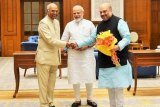Film Review: Lootera starring Sonakshi Sinha and Ranveer Singh
A certain school of filmmaking in Bollywood equates lavish production design, pretty people in gorgeous locations, melodious songs and operatic background score with great cinema. I’m thinking of Vidhu Vinod Chopra’s 1942: A Love Story, Sanjay Leela Bhansali’s Devdas and now, Motwane’s Lootera, which could be politely described as ‘misguided epics’. But in an environment where Black was quickly anointed a ‘classic’ bringing Saawariya and Guzaarish to our doorstep, their failings aren’t likely to be discussed with any seriousness.
There’s a thing that happens between actors on screen which makes us fall in love with them. It’s called chemistry. And sometimes it transcends the atmosphere around the film. Take Casablanca, for instance, in which Humphrey Bogart and Ingrid Bergman reportedly weren’t on the best of terms but their doomed on-screen romance resonates to this day. Or Mughal-E-Azam through the decade-long making of which, Dilip Kumar and Madhubala went from love to acrimony via an infamous court case, but all you remember is the ‘feather scene’. In Silsila, Amitabh Bachchan and Rekha look so good together you ignore the banality of the film and forget the tantalising real-life drama behind the scenes. The same ubiquitous chemistry obfuscates the tackiness of Aradhana as Rajesh Khanna and Sharmila Tagore gaze into each other’s eyes with naked adoration on a rainy night.
More like this
Similarly, memorable characters are often an amalgam of great writing and star charisma. Chhoti Bahu is as much about the Meena Kumari persona as it is the tragedy of a lonely wife condemned to make and break jewellery for the rest of her life. Rajesh Khanna’s romantic image married to Gulzar’s philosophical musings gives us a great treatise on the joy of living as Anand—“Zindagi badi honi chaahiye, lambi nahin,” he enthusiastically expounds. “Main aaj bhi phenke hue paise nahin uthaata” declares Vijay of broody eyes and rich baritone and you fall in love with Bachchan the superstar.
Now pardon the irreverence, but I was watching Ranveer Singh in Lootera and kept thinking he was about to stop mumbling his lines anytime now, shake off the hair gel, drop the frown along with the high-waist khakhis and Timberland boots to jump straight into the pool at Bandra’s Otters Club. That's how inauthentic he looks and behaves! And it's as much a function of the weak writing (screenplay: Bhavani Iyer and Vikramaditya Motwane, Dialogue: Anurag Kashyap) as his own limitations. Because you never really get to know the man behind the sulk, beyond the fact that he was orphaned in childhood, raised by an ‘uncle’ and claims to be an archaeologist. Since the film is called Lootera, his suspicious behaviour is precursor to a very lame suspense.
Similarly you see Sonakshi Sinha––she fares considerably better than Singh on the acting register––looking gorgeous and trying to make the most of a confusing part. She’s a zamindar’s (Barun Chanda) daughter who wants to be a writer and dabbles in painting. She’s also asthmatic and there’s your instant recipe for melodrama. The father-daughter relationship is reminiscent of Ashok Kumar and Jaya Bhaduri in Mili, not a great film by any stretch but certainly a bonafide tearjerker.
The zamindar is the film's most interesting character and its best performance too––unable to keep step with the times and at the mercy of the newly formed Indian state, a doting father and vulnerable old man. At one point he tells Varun something to the effect, "This is now your new country; people like me have become out-dated." What the youth finally did to this country is a matter of historical record and again ties in with the film’s title although one isn’t sure Motwane wanted to go in that direction.
The Paakhi-Varun romance unfolds at a languorous pace and it’s refreshing just to see two people hesitate and trade silences instead of cocky witticisms and sit three feet apart on an ornate sofa to pose before a rudimentary camera. She stands by the same shuttered windows Charulata gazed at the world from and so much of the production design reminds you of Rituparno Ghosh’s best work, you fervently wish the narrative would match its poignancy and insight. But it doesn’t and you start comparing Sonakshi’s latticed blouse to Madhuri Dixit’s from the original 1942 photo-shoot.
Being the 1950s, can homage to the golden age be left out? He shaves in the courtyard while Geeta Dutt croons “Tadbir se bigdi hui taqdeer bana le” on the antiquated radio and Varun’s friend (Vikrant Massey) does an imitation of Dev Anand’s sloppy charm. K N Singh (Adil Hussain) shows up in the second half and the Baazi nod is complete, although it seems as contrived as everything else.
Yet there are a couple of genuinely emotive moments––when he holds her close in the car on a deserted road after she takes ill or they’re wandering through the woods painting a landscape and the film’s best composition, “Sanwaar loon” lends voice to the stirrings of their heart. But nothing completely takes your mind off the pretty furniture––not even when she walks into his room in the dead of the night Paro-like demanding that he express his feelings.
So that by the time she tells Inspector Singh, “Main usse badla nahin lena chahti, sirf use bhool jaana chahti hoon,” you really don’t care (besides Sonakshi's Dabangg dialogue is echoing in your head––"Thappad se dar nahin lagta sahab, pyaar se lagta hai" for no apparent reason). Varun has caused Paakhi such untold misery, you’re horrified to think she still loves him, although that’s usually what Hindi film heroines do in their masochistic resolve to pine for undeserving men.
Lootera has opened to glowing reviews; perhaps we use words like ‘masterpiece’ far too casually. Incidentally, like Mr Behrman of O. Henry's short story The Last Leaf from which the film draws its premise, the hero too wants to paint a masterpiece. The original is a simple tale that brings to mind a quote from Virginia Woolf––“Someone has to die so that the rest of us should value life more.”
Deepa Deosthalee is a film critic and a regular contributor to Cinemascope column. The views and opinions expressed in this article are those of the author and does not reflect the views of IndiaNewsBulletin.com. More of Deepa's work can be found on her site Film Impressions.
Most read
- 2017: Full list of Indian States, capitals and their Chief Ministers; Nitish Kumar quits and takes oath again as Bihar CM!
- Ram Nath Kovind is 14th Indian President after Pranab Mukherjee. Here's a list of all Indian Presidents since 1950
- List of all the major rivers of India: Names, Origin and Length
- Indian cabinet September 2017: Full list of Ministers and their portfolios in Narendra Modi government
- Indian Independence Day Celebrations 2017: 71st Independence Day at London's The Bhavan on Aug 3; At Osterley Indian Gymkhana on Sept 10
- Osterley Gymkhana London hosts 70th Indian Independence Day Celebrations
- Dosa recipe: How to make crispy Paper Dosa and Masala Dosa
- Recipe: Misal Pav – how to make missal masala, usal and tarri
- South Indian actress Trisha Krishnan’s father passes away
- Rana Daggubati, Tamannah, Prabhas, Anushka starrer epic film Baahubali made for 2.5 billion INR releases
India News Bulletin by email
More Lead Stories
- Osterley Gymkhana London hosts 70th Indian Independence Day Celebrations
- Indian tourists involved in fatal collision on M1 motorway involving minibus and 2 lorries
- 2017: Full list of Indian States, capitals and their Chief Ministers; Nitish Kumar quits and takes oath again as Bihar CM!
- Indian train meals not protected from rats, cockroaches, dust, insects, warn auditors
- IIFA 2017 New York Pics: Bollywood stars ooze glamour at the green carpet











